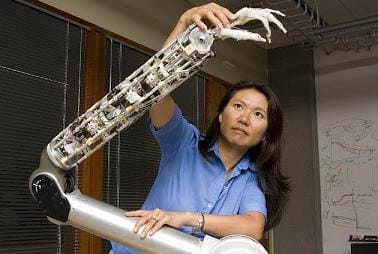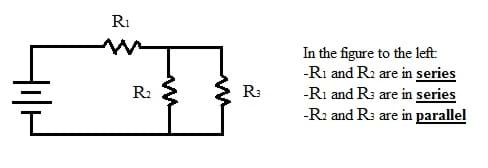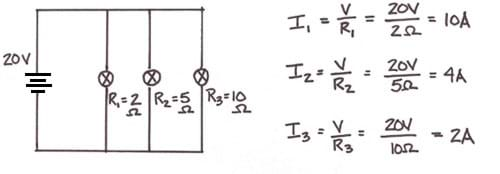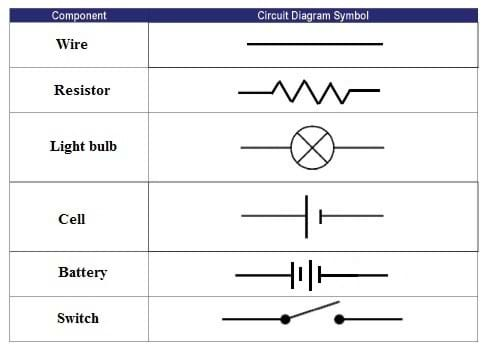Summary
Students explore the composition and practical application of parallel circuitry, compared to series circuitry. Students design and build parallel circuits and investigate their characteristics, and apply Ohm's law.
Engineering Connection
Engineers have developed a very complicated circuit — called an integrated circuit — that combines thousands to millions of parallel and series circuits working together. One type of integrated circuit that works as a complete computation engine is a microprocessor, known as a central processing unit or a CPU. Microprocessors are essential in automobiles, video games, smoke detectors, DVD players, garage-door openers, cordless phones, clocks and calculators. Engineers continuously develop new technology so that they may use electricity to find solutions to everyday challenges — efforts that contribute to a healthier, happier, and safer environment.
Learning Objectives
After this lesson, students should be able to:
- Distinguish between series and parallel parts of a circuit.
- Describe how current changes in a parallel circuit when a light bulb is removed from or added to the circuit.
- Describe the connections among representations of circuit symbols
- Recognize that electrical engineers, materials scientists/engineers, mechanical engineers, and physicists contribute to the development of electronic technologies.
Educational Standards
Each TeachEngineering lesson or activity is correlated to one or more K-12 science,
technology, engineering or math (STEM) educational standards.
All 100,000+ K-12 STEM standards covered in TeachEngineering are collected, maintained and packaged by the Achievement Standards Network (ASN),
a project of D2L (www.achievementstandards.org).
In the ASN, standards are hierarchically structured: first by source; e.g., by state; within source by type; e.g., science or mathematics;
within type by subtype, then by grade, etc.
Each TeachEngineering lesson or activity is correlated to one or more K-12 science, technology, engineering or math (STEM) educational standards.
All 100,000+ K-12 STEM standards covered in TeachEngineering are collected, maintained and packaged by the Achievement Standards Network (ASN), a project of D2L (www.achievementstandards.org).
In the ASN, standards are hierarchically structured: first by source; e.g., by state; within source by type; e.g., science or mathematics; within type by subtype, then by grade, etc.
NGSS: Next Generation Science Standards - Science
| NGSS Performance Expectation | ||
|---|---|---|
|
4-PS3-2. Make observations to provide evidence that energy can be transferred from place to place by sound, light, heat, and electric currents. (Grade 4) Do you agree with this alignment? |
||
| Click to view other curriculum aligned to this Performance Expectation | ||
| This lesson focuses on the following Three Dimensional Learning aspects of NGSS: | ||
| Science & Engineering Practices | Disciplinary Core Ideas | Crosscutting Concepts |
| Make observations to produce data to serve as the basis for evidence for an explanation of a phenomenon or test a design solution. Alignment agreement: | Energy can be moved from place to place by moving objects or through sound, light, or electric currents. Alignment agreement: Energy is present whenever there are moving objects, sound, light, or heat. When objects collide, energy can be transferred from one object to another, thereby changing their motion. In such collisions, some energy is typically also transferred to the surrounding air; as a result, the air gets heated and sound is produced.Alignment agreement: Light also transfers energy from place to place.Alignment agreement: Energy can also be transferred from place to place by electric currents, which can then be used locally to produce motion, sound, heat, or light. The currents may have been produced to begin with by transforming the energy of motion into electrical energy.Alignment agreement: | Energy can be transferred in various ways and between objects. Alignment agreement: |
Common Core State Standards - Math
-
Multiply a whole number of up to four digits by a one-digit whole number, and multiply two two-digit numbers, using strategies based on place value and the properties of operations. Illustrate and explain the calculation by using equations, rectangular arrays, and/or area models.
(Grade
4)
More Details
Do you agree with this alignment?
-
Solve real-world and mathematical problems by writing and solving equations of the form x + p = q and px = q for cases in which p, q and x are all nonnegative rational numbers.
(Grade
6)
More Details
Do you agree with this alignment?
International Technology and Engineering Educators Association - Technology
-
Tools, machines, products, and systems use energy in order to do work.
(Grades
3 -
5)
More Details
Do you agree with this alignment?
-
Explain how various relationships can exist between technology and engineering and other content areas.
(Grades
3 -
5)
More Details
Do you agree with this alignment?
State Standards
Colorado - Math
-
Assess the reasonableness of answers using mental computation and estimation strategies including rounding.
(Grade
4)
More Details
Do you agree with this alignment?
-
Find the unknown in simple equations.
(Grade
4)
More Details
Do you agree with this alignment?
Colorado - Science
-
Show that electricity in circuits requires a complete loop through which current can pass
(Grade
4)
More Details
Do you agree with this alignment?
-
Describe the energy transformation that takes place in electrical circuits where light, heat, sound, and magnetic effects are produced
(Grade
4)
More Details
Do you agree with this alignment?
Pre-Req Knowledge
Series circuits
Introduction/Motivation
Ask students to raise their hands if they have ever used a videogame, a remote control (for a television or other electronic device) or a keyboard. Ask if any of them ever had just one button or key stop working, while the rest of the videogame controller, remote control or keyboard continued to work. What is occurring electronically that causes this to happen? How can only one button be broken but the rest of the controller still work?
Ask the students if they have ever walked into a room that has multiple lights and they only turned on one. Remind students of the in series circuits they built previously. When one light bulb was taken out of the circuit, an open circuit was created and the electrons could not flow to light the other bulbs. Now ask them, how is it possible that you can turn on one light in a room, and it will work, yet you did not have to turn on all of the other lights?
Explain to students that these two examples use parallel circuits. Engineers connect things in parallel, so if one circuit part breaks the rest of the circuit still works.
Ask for three volunteers. Assign one volunteer to be the "battery" and two as 'light bulbs." (It may help to draw the appropriate symbols on pieces of paper and tape them to their shirts.) Have the students physically portray a series circuit by holding hands in a circle. Then have the students portray a parallel circuit by having the light bulbs and battery stand facing one direction with their arms touching the elbows of the person in front of them.
A very complicated circuit that combines thousands to millions of parallel and series circuits working together is called an integrated circuit (see Figure 1). A microprocessor, known as a central processing unit or a CPU, is a type of integrated circuit that works as a complete computation engine. These days, an average U.S. home has about 40 of these microprocessors in addition to the 10 or so in a typical personal computer alone. Microprocessors are in automobiles, video games, smoke detectors, DVD players, garage-door openers, cordless phones, clocks, and calculators. They are even being implanted in animals as an electronic identity tag.

Lesson Background and Concepts for Teachers
Parallel Circuits
A parallel circuit and its corresponding circuit diagram are shown in Figure 2. Since there is more than one path for charge to flow as it moves through the circuit, the current is divided between the two bulbs. Therefore, the current is the same before the bulbs (at the node; intersection of two wires) and after the bulbs (at the node; intersection of two wires), but is divided at the bulbs. In other words, the total current in the circuit is equal to the sum of the currents in the parallel portions. Note, that if the bulbs have the same resistance the current is divided equally among them. On the other hand, if the bulbs have different resistances, the bulb with greater resistance has less current. The total resistance of the circuit decreases if the number of parallel paths increases. The voltage drop across each part of a parallel circuit is the same because each part is connected across the same two points. Students can practice constructing their own parallel circuits with the associated activity Bulbs & Batteries Side by Side.

When batteries are linked in parallel, the total current produced increases. For example, if we made a circuit using three 1.5 V batteries in parallel as the voltage source, the total voltage provided by the battery bank would still be 1.5 V. However, the current would be three times that of a single 1.5 V battery. Remember that the amount of current in the circuit depends on the resistances of the devices in the circuit. When an engineer designs a device, like a portable CD player, s/he decides how many batteries are needed in parallel to provide enough current. As you can see, electrical engineers must be very knowledgable about electcitity, yet get to be very creative in their work!
Electricity in the Home
When you plug an appliance into a wall outlet in your home, you are adding a parallel branch to a circuit that goes all the way to your local power plant. Connected to the wall outlets are two wires called lines; one line is called the live wire, while the other is the neutral wire. These lines supply alternating current (AC) at 110-120 V. Often, a third contact in a wall outlet is a ground wire. The ground wire is connected directly to the earth to direct current into the ground if the live wire accidentally touches metal on an appliance. This prevents anyone touching the appliance from receiving an electric shock. Of course, the appliance must be connected to the ground wire, either with an adaptor or a three-prong plug. Engineers are responsible for making appliances safe to use; proper grounding is an import design consideration and they are concerned at all times with public safety.
Electric Power
Whenever there is current in a circuit, electrical energy is being used to do some type of work and electrical energy is being transformed into another type of energy. This work might be turning the blades of a fan, lighting a room, or heating food. The rate at which this work is done by a charge in a circuit is electric power. Electric power is also the rate at which electrical energy is used, therefore, Power = Energy / Time. The electric power consumed by an appliance is P = I * V, where P is the electric power, I is the current in the appliance in amperes [A], and V is the voltage of the appliance in volts [V]. Therefore, electric power is expressed in watts (W), where 1 W = 1 A * V. The cost of electrical energy is given in cents per kilowatt-hour (kWh), where 1 kWh = 1000 Wh (Watt hour). A kilowatt-hour is the amount of electrical energy used in one hour at a rate of 1 kW. Designing appliances that consume power efficiently is an important objective for engineers that ultimately helps improve society.
Associated Activities
- Bulbs & Batteries Side by Side - Students build and modify a parallel circuit, learning more about Ohm's law.
Lesson Closure
Have students suggest examples of devices that contain computer chips; write the item names on the board. (Possible answers: Microwave oven, answering machine, car, DVD player, etc.) Then, draw a circuit with several components on the board (see Figure 3 for an example sketch). Ask the class to identify which components of the circuit are connected in series and which are connected in parallel

Next, draw on the board a circuit diagram as seen in Figure 4. Use Ohm's law (I = V / R) to compare the current in three bulbs, each with increasing resistance connected in a parallel arrangement. (Answer: See Figure 4 calculations. Current is greatest in the bulb with the least resistance and least in the bulb with the greatest resistance.) Ask what happens to the voltage when batteries are connected in parallel? (Answer: The voltage across the terminals stays the same.)

Vocabulary/Definitions
integrated circuit: A microelectronic circuit etched or imprinted on a semiconductor chip.
parallel circuit: An electric circuit providing more than one conducting path.
Assessment
Pre-Lesson Assessment
Discussion Questions: Ask the students and discuss as a class:
- With what type of circuit would you want your house or video game wired, and why? (Answer: Students will probably recall the lesson on series circuit and explain how that type of circuit works. Discuss the pros and cons of series circuits.)
- If you remove one bulb from a series circuit with three bulbs, the circuit will be a(n) ____________ circuit. Open or closed? (Answer: Open.)
- What happens to the other bulbs in a series circuit if one bulb burns out? (Answer: They all go out.)
- When batteries are connected in series, the voltage across them ____________. Increases, decreases, or stays the same? (Answer: Increases to the total summative value of the battery voltage.)
Post-Introduction Assessment
Question/Answer: Ask the students questions and have them raise their hands to respond. Write answers on the board
- How is it possible that you can turn on one light in a room, and it works, without you having to turn on all of the other lights? (Answer: The wiring in a house is a parallel circuit.)
- What is the name for a very complicated circuit that combines thousands to millions of parallel and series circuits working together? (Answer: An integrated circuit or microprocessor.)
Lesson Summary Assessment
Numbered Heads: Divide the class into teams of three to five. Have the students on each team number off so each member has a different number. Ask the students questions (give them a time frame for solving each, if desired). The members of each team should work together to answer the questions. Everyone on the team must know the answer. Call a number at random. Students with that number should raise their hands to give the answer. If not all students with that number raise their hands, allow the teams to work a little longer. Ask the students:
- If you remove one bulb from a parallel circuit with three bulbs in parallel, the circuit becomes a(n) ____________ circuit. Open or closed? (Answer: Closed.)
- What happens to the other bulbs in a parallel circuit if one bulb burns out? (Answer: They stay lit.)
- When bulbs are connected in parallel, the total resistance is ____________ the resistance of one bulb. Less than, greater than or the same as? (Answer: Less than.)
- When batteries are connected in parallel, the voltage across them ____________. Increases, decreases or stays the same? (Answer: Stays the same.)
- Draw a circuit diagram of a parallel circuit with two batteries in parallel and two light bulbs in parallel.
Drawing Race: Write the circuit symbols on the board (see Figure 5). Divide the class into teams of four, having each team member number off so each has a different number, one through four. Call a number and have students with that number race to the board to draw the correct circuit diagram. Give a point to the team whose teammate first finishes the drawing correctly. Ask the students to draw circuit diagrams of the following:
- A circuit with one battery and two light bulbs in parallel.
- A circuit with three batteries in parallel and two light bulbs in parallel.
- A circuit with two batteries in parallel, one resistor and one light bulb.
- A circuit with one battery, one switch and three light bulbs in parallel.
- A circuit with one battery, one switch and two resistors in parallel.
- A circuit with one battery, one switch and one light bulb and resistor in parallel.
- A circuit with two batteries in parallel and one light bulb in parallel with a light bulb and resistor.

Class Presentation: Working in groups of two to four, have students give a class presentation in which they dynamically act out the concepts they learned in the unit. Encourage role-playing and creativity.
- Have the students act out the scenario of an electrical engineer who has just invented a new toy using series or parallel (or combination of both) circuits. Other players can be consumers, patent officials, neighbors, other engineers, etc. Each scenario must include a description of the circuit and how it works, as well as a drawing of the circuit on the board.
Lesson Extension Activities
Have students investigate the history of the computer industry and the integrated circuit. They can prepare posters and presentations on key inventions and the engineers and researchers who played important roles in the development of microchips and microprocessors.
Microchips are being increasingly used in devices, for example, in clothing irons that automatically shut themselves off, and toasters that detect perfectly browned toast. Have the students all the home appliances that they can think of that have a microchip. Microchips are in dishwashers, washing machines and dryers, televisions, microwave ovens, automobiles, VCRs, DVD players, satellite dish receivers, remote controls, video games, cameras, camcorders, smoke detectors, garage-door openers, cordless phones, mobile phones, fax machines, telescopes, GPS receivers, radios, keyboards, MP3 players, tape decks, stereos, clocks, calculators, printers, scanners, PDAs and animal identity tags.
Expressions and Equations: Have students solve Ohm's law (I = V / R) in the lesson closure for various variables including voltage, current, and resistance instead of just current.
Subscribe
Get the inside scoop on all things TeachEngineering such as new site features, curriculum updates, video releases, and more by signing up for our newsletter!More Curriculum Like This

Students learn that charge movement through a circuit depends on the resistance and arrangement of the circuit components. In one associated hands-on activity, students build and investigate the characteristics of series circuits. In another activity, students design and build flashlights.

Students are introduced to several key concepts of electronic circuits. They learn about some of the physics behind circuits, the key components in a circuit and their pervasiveness in our homes and everyday lives.

Students learn about current electricity and necessary conditions for the existence of an electric current. Students construct a simple electric circuit and a galvanic cell to help them understand voltage, current and resistance.

Students imagine they are stranded on an island and must create the brightest light possible with the meager supplies they have on hand in order to gain the attention of a rescue airplane. In small groups, students create circuits using items in their "survival kits" to create maximum voltage, measu...
References
Hewitt, Paul G. Conceptual Physics. 8th Edition. New York, NY: Addison Publishing Company, 1998.
Kagan, Spencer. Cooperative Learning. Capistrano, CA: Kagan Cooperative Learning, 1994. (Source for Numbered Heads assessment activity.)
Reid, T.R. The Chip: How Two Americans Invented the Microchip and Launched a Revolution. New York, NY: Random House, 2001, pg. 309.
Copyright
© 2004 by Regents of the University of Colorado.Contributors
Xochitl Zamora Thompson; Sabre Duren; Daria Kotys-Schwartz; Malinda Schaefer Zarske; Denise Carlson; Janet YowellSupporting Program
Integrated Teaching and Learning Program, College of Engineering, University of Colorado BoulderAcknowledgements
The contents of this digital library curriculum were developed under a grant from the Fund for the Improvement of Postsecondary Education (FIPSE), U.S. Department of Education and National Science Foundation GK-12 grant no. 0338326. However, these contents do not necessarily represent the policies of the Department of Education or National Science Foundation, and you should not assume endorsement by the federal government.
Last modified: June 20, 2025










User Comments & Tips